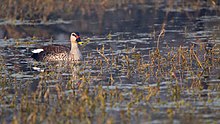Spotbill
| Indian spot-billed duck | |
|---|---|
 |
|
| Indian spot-billed duck (A. poecilorhyncha) |
|
| Scientific classification | |
| Kingdom: | Animalia |
| Phylum: | Chordata |
| Class: | Aves |
| Order: | Anseriformes |
| Family: | Anatidae |
| Genus: | Anas |
| Species: | A. poecilorhyncha |
| Binomial name | |
|
Anas poecilorhyncha Forster, 1781 |
|
| Subspecies | |
|
|
The Indian spot-billed duck (Anas poecilorhyncha) is a dabbling duck which breeds throughout the Indian subcontinent. The name is derived from the yellow and red spot on the bill. The eastern spot-billed duck (A. zonorhyncha) was at one time treated as a subspecies.
The Indian spot-billed duck was described by the naturalist Johann Reinhold Forster in 1781 under its current binomial name Anas poecilorhyncha. The name of the genus Anas is the Latin word for a duck. The specific epithet poecilorhyncha combines the classical Greek words poikilos meaning "pied" or "spotted" and rhunkhos meaning a "bill".
A molecular phylogentic study published in 2009 that compared sequences from ducks, geese and swans in the family Anatidae found that the Indian spot-billed duck was a sister species to a clade containing the Mexican duck, the American black duck, the mottled duck and the mallard.
Two subspecies are now recognised:
The eastern spot-billed duck was formerly considered as a third subspecies. Fieldwork carried out at Hong Kong in southern China and published in 2006 found that although both the eastern spot-billed duck and the Indian spot-billed duck (subspecies A. p. haringtoni) bred in the region at the same time, mixed pairs were only very rarely observed. Based on this observation most taxonomists now treat the eastern spot-billed duck as a separate species.
This duck is around the same size as a mallard and has a scaly patterned body with a green speculum bordered by white. At rest the white stripe stands out and the long neck and the bill with yellow tip and orange red spots at the base are distinctive in the nominate subspecies. The red spots at the base of the bills are absent in haringtoni. It measures 55–63 cm (22–25 in) in length and 83–95 cm (33–37 in) across the wings, with a body mass of 790–1,500 g (1.74–3.31 lb). These are mainly grey ducks with a paler head and neck and a black bill tipped bright yellow. The wings are whitish with black flight feathers below, and from above show a white-bordered green The male has a red spot on the base of the bill, which is absent or inconspicuous in the smaller but otherwise similar female. The male does not have an eclipse plumage. The legs and feet are bright orange. Juveniles are browner and duller than adults.
...
Wikipedia

